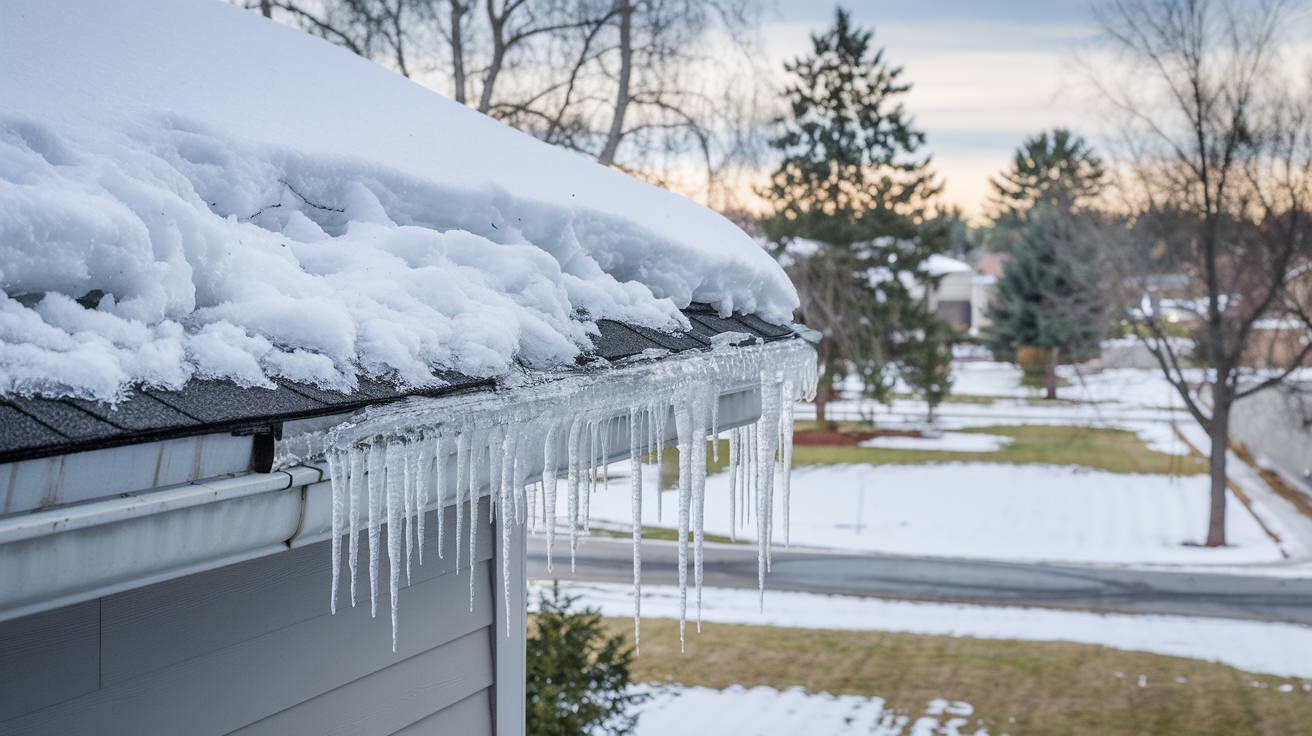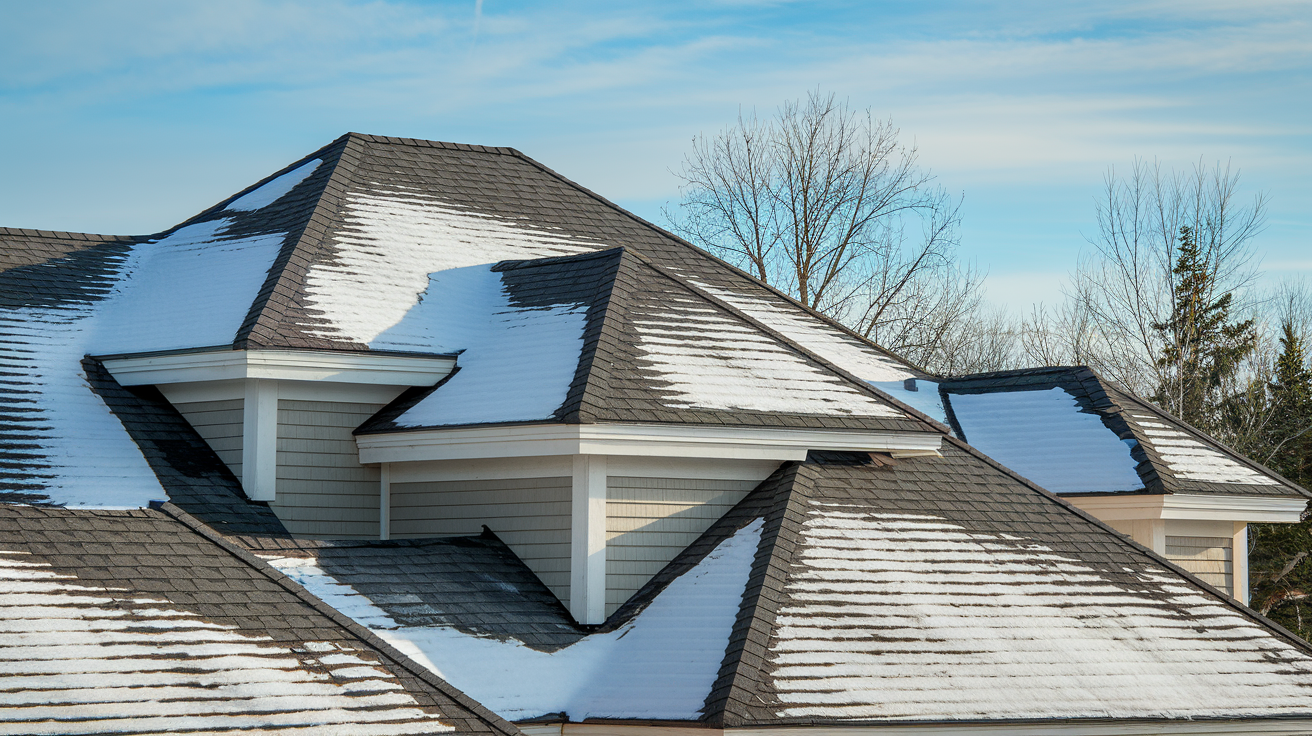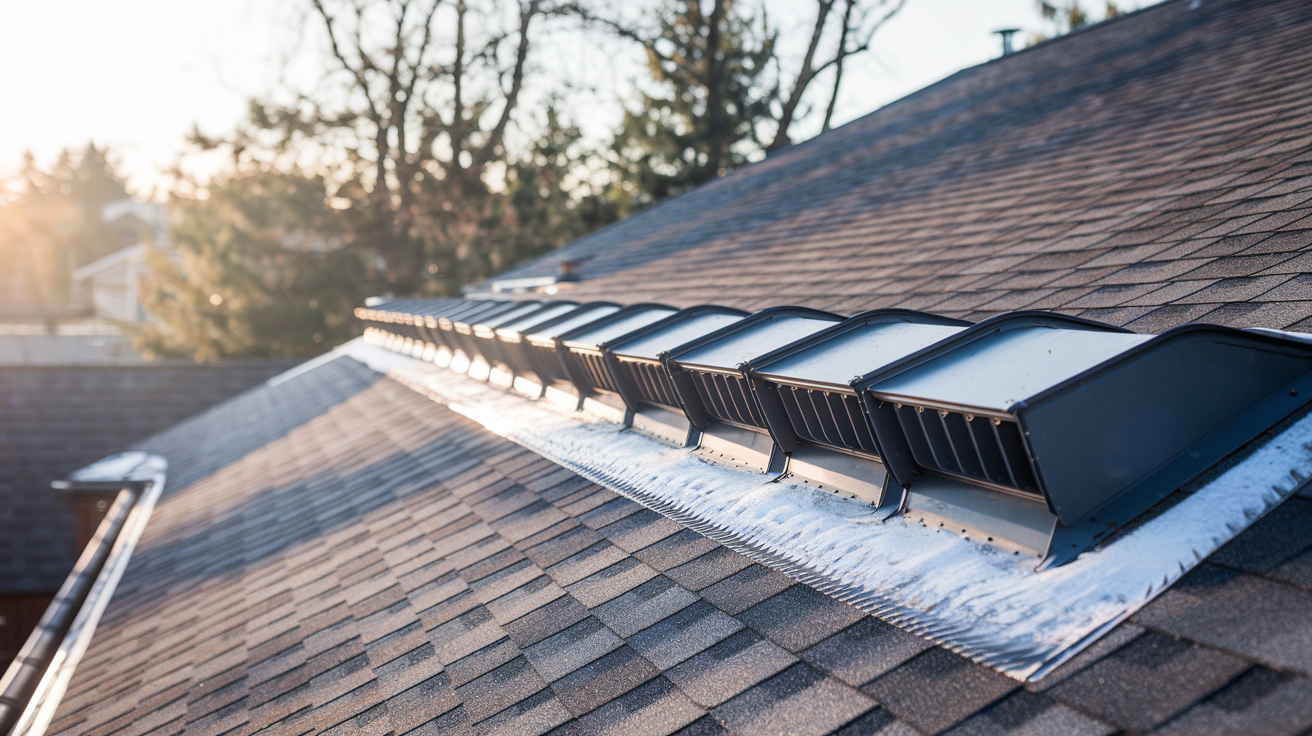Prevent Ice Dams: Expert Guide to Protecting Your Roof This Winter
Every winter, thousands of homeowners face a silent threat lurking on their roofs - ice dams. These seemingly harmless ridges of ice cause over $400 million in property damage annually across cold-weather states. When melting snow refreezes at your roof's edge, it creates a barrier that can trap water, leading to costly leaks, mold growth, and structural damage.
For the average homeowner, ice dam repairs cost between $2,000 to $20,000 - not including potential damage to personal belongings or health impacts from toxic mold. Yet despite these risks, many people don't recognize the warning signs until it's too late. Understanding ice dams and taking preventive action is crucial for protecting your home and wallet.
In this comprehensive guide, you'll learn what causes ice dams, how to spot early warning signs, and proven strategies to prevent them. We'll explore both DIY solutions and professional options, helping you make informed decisions about protecting your home. Whether you're dealing with ice dams now or want to prevent future problems, this article provides the practical insights you need.
- Understanding Ice Dams
- Causes and Contributing Factors
- Risks and Damages from Ice Dams
- Prevention and Mitigation Strategies
- Professional Solutions and Considerations
Understanding Ice Dams
Ice dams are a common winter problem for homes in colder climates. If not addressed, they can cause significant damage and lead to costly repairs. Understanding how they form and impact your home is crucial for prevention and effective management. Knowledge about ice dams can save homeowners money and stress.
What Are Ice Dams?
Ice dams are ridges of ice that form along the eaves of roofs. They trap melting snow and prevent it from draining. This trapped water can leak into your home, damaging ceilings, walls, insulation, and other areas. The weight of an ice dam can also be a problem, with small ice dams weighing a few hundred pounds and larger ones weighing thousands. This weight can cause structural problems like damaged shingles and sagging gutters, and it can lead to damaged insulation and water stains inside. Water trapped behind the dam can leak through the roof and damage walls, ceilings, and insulation. Ice dams also threaten the building's structure and can increase heating costs due to heat loss. Consider getting a roof assessment to identify potential vulnerabilities.

How Ice Dams Form on Roofs
Ice dams form when heat from inside your home escapes into the attic, warming the roof and melting the snow. The melted snow flows down until it reaches the colder eaves, where it refreezes and forms an ice dam. Both internal and external heat sources can create uneven roof temperatures. As more snow melts, it gets trapped behind the dam, making it bigger and potentially causing leaks. Houses that maintain a below-freezing roof temperature can prevent this. Poor insulation and ventilation exacerbate the problem by creating uneven temperatures across the roof. Proper attic ventilation can cool the roof and make ice dams less likely. To learn more about roof maintenance and prevent ice dams, explore our resources.
Tip for Preventing Ice Dams
Ensure your attic is well-insulated and ventilated to maintain a consistent temperature and prevent snowmelt that leads to ice dam formation.
Key Statistics on Ice Dam Incidents
Ice dams are common in cold, snowy areas, especially U.S. climate zones 5 and greater. These areas have long periods of freezing temperatures and snowfall, perfect for ice dam formation. Ice dams cause millions of dollars in property damage every year, with repair costs sometimes reaching $20,000. Professional ice dam removal costs between $475 and $875 per hour, depending on the severity of the dam and the complexity of the roof. For a typical two-story, 1500 sq. ft. home, the average removal cost is around $1200 for about three hours of work. Preventing ice dams usually involves professional solutions addressing root causes, along with better attic insulation and ventilation. New homes should meet or exceed state requirements for ceiling and roof insulation to prevent ice dams.
Causes and Contributing Factors
Understanding the causes and contributing factors of ice dams is crucial for effective prevention and management. Ice dams primarily form due to heat escaping from a home's living spaces, warming the roof and causing snow to melt. This melted snow refreezes at the colder eaves, creating the ice dam. Several factors contribute to ice dam formation, including heat loss, insulation quality, ventilation, and roof design. By understanding and addressing these factors, homeowners can protect their properties from costly ice dam damage. Consider a roof assessment to identify potential vulnerabilities.
The Role of Heat Loss and Temperature Fluctuations
Heat loss is a major contributor to ice dam formation. When warm air escapes into the attic, it raises the roof temperature above freezing, causing snow to melt. This meltwater flows down the roof until it reaches the colder eaves, where it refreezes and forms the ice dam. Temperature fluctuations worsen this problem by causing repeated melting and refreezing, which increases the ice dam's size and potential for damage. Effectively sealing air leaks and maintaining consistent attic temperatures can help mitigate this issue.
| Heat Source | Description |
|---|---|
| Internal | Poorly insulated heating ducts, recessed lighting fixtures. |
| External | Direct sunlight on roof areas causing uneven heating. |
Impact of Poor Insulation and Ventilation
Insufficient insulation and ventilation are key factors in ice dam formation. Poor insulation allows heat to escape into the attic, warming the roof and melting snow. This creates ideal conditions for ice dams, especially when the under-roof temperature exceeds 30°F (-1°C). Inadequate ventilation further exacerbates the issue by failing to cool the roof deck. Proper ventilation circulates cold outside air in the attic, helping to maintain a roof deck temperature closer to the outside air temperature. To learn more about roof maintenance and understand the importance of proper ventilation, explore our resources.
Importance of Proper Insulation and Ventilation
Ensuring adequate insulation and ventilation significantly reduces the risk of ice dams.
- Insulation: While an R-value of 60 is often recommended, no amount of insulation fully guarantees prevention.
- Ventilation: Attic ventilation cools the roof deck, reducing the likelihood of ice dam formation. It works with insulation to maintain a consistently cold roof.
Influence of Roof Design and Construction
A roof's design and construction also influence ice dam formation.
Roof Complexity and Drainage
Roofs with complex designs, valleys, or low slopes are more susceptible to ice dams because they trap snow and hinder drainage. Trapped snow is more likely to melt and refreeze, resulting in larger, more damaging ice dams.

Building Codes and Thermal Shorts
New construction should meet or exceed state code requirements for ceiling and roof insulation to effectively prevent ice dams. Adhering to these codes helps maintain a consistently cold roof temperature, key to preventing ice dam formation. "Thermal shorts" in insulation, where insulation is improperly installed or missing, can also contribute to ice dam formation. These shorts allow heat to escape directly through the roof. Examples include gaps around plumbing vents or recessed lighting. Considering these design aspects during construction or renovation can minimize ice dam problems.
Risks and Damages from Ice Dams
Ice dams can cause significant damage to your home, resulting in costly repairs and potential health hazards. They form when heat escapes from your home into the attic and melts snow on the roof. This melted snow then refreezes at the colder eaves. Understanding these risks is crucial, especially for homeowners in colder climates.
Common Types of Roof and Structural Damage
Ice dams threaten the structural integrity of your roof. Water backs up behind the ice dam and seeps under roof shingles, damaging them and the underlying roof decking. The weight of the ice can also cause sagging gutters and damage the fascia.
Effects of Ice Dam Weight
The weight of even a small ice dam can range from hundreds to a thousand pounds. Larger ice dams, especially those causing leaks, can weigh several thousand pounds. This weight can stress the roof structure.
Water Damage Under Shingles
Melted snow refreezes at the eaves, forming an ice dam that prevents runoff. The trapped water then goes under the shingles, causing leaks and rot. In severe cases, this can lead to roof leaks and compromise the structural stability of your home, even increasing the risk of collapse. Consider a roof assessment to identify potential vulnerabilities.
Average Ice Dam Damage Costs
$20,000
Potential property damage
Water Leakage, Mold, and Mildew Concerns
Water leakage is a major concern with ice dams. As water enters your home, it damages walls, ceilings, insulation, and potentially electrical wiring and belongings in the attic. This moisture encourages mold and mildew growth, creating health risks for your family.
Health Risks of Mold and Mildew
Mold and mildew release spores that trigger allergic reactions and respiratory problems. If left untreated, they can spread, impacting air quality and leading to more severe health issues.
Preventing Mold and Mildew
Preventive measures, such as improving attic insulation and ventilation, can mitigate these risks. These measures help keep the roof surface temperature below freezing, preventing snowmelt that forms ice dams. To learn more about roof maintenance, explore our resources.
Ice dam damage can be expensive. Removing ice dams from a typical two-story home costs around $1,200. However, extensive water damage or structural repairs can significantly increase this cost.
Range of Repair Costs
Some homeowners report property damages exceeding $20,000 due to ice dams. This includes repairing or replacing roofs, ceilings, walls, insulation, and personal belongings. Industry data shows that about 1 in 60 insured homes files a water or freezing damage claim yearly.
Professional Ice Dam Removal Costs
Professional ice dam removal costs between $475 and $875 per hour. This varies depending on factors like the ice dam's size, roof accessibility, and property location. Investing in preventive measures, especially during new construction, can prevent these costly repairs.
Prevention and Mitigation Strategies
Ice dams pose a significant winter threat to homeowners, but implementing the right prevention and mitigation strategies can protect your home. Water backing up behind an ice dam can infiltrate the roof, causing damage to walls, ceilings, insulation, and other areas. This can also lead to damaged shingles and sagging gutters, resulting in costly repairs. This section explores practical solutions, including improving attic insulation, enhancing roof ventilation, and performing regular roof maintenance, to safeguard your roof during freezing temperatures.
Improving Attic Insulation
One of the most effective ice dam prevention strategies is enhancing attic insulation. Inadequate insulation allows heat to escape into the attic, warming the roof and melting snow, which then refreezes at the colder eaves, forming ice dams.
Attic Insulation Checklist
- ✔ Ensure minimum R-value of R-30
- ✔ Prefer R-38 in colder climates
- ✔ Consider R-60 for optimal performance
- ✔ Address any insulation gaps
Recommended R-Values
Experts recommend a minimum attic insulation R-value of R-30, with R-38 preferred in colder climates. R-value measures insulation's resistance to heat transfer; a higher R-value indicates better insulation. For example, R-38 insulation provides greater resistance than R-30. While no insulation guarantees complete prevention, higher R-values significantly mitigate the risk. Some energy auditors even recommend R-60 for optimal performance. Proper attic insulation minimizes heat transfer, reducing ice dam risk. You can learn more about roof maintenance to understand the benefits of proper insulation.
New Construction Considerations
For new construction, adhering to or exceeding state code requirements for ceiling and roof insulation is crucial. This ensures adequate insulation from the outset.
Enhancing Roof Ventilation
Proper roof ventilation is essential for ice dam prevention. It maintains a consistent roof temperature, minimizing the temperature difference between the warm roof and the freezing eaves.
Best Practices
Ventilation cools the roof deck, reducing snowmelt and refreezing. Effective ventilation systems often incorporate ridge vents at the roof's peak for air exhaust and soffit vents at the eaves for air intake, facilitating natural airflow.
Mechanical Ventilation
Sometimes, mechanical ventilation, such as powered fans, becomes necessary to maintain an attic temperature of -1°C (30°F), especially in attics with complex designs or limited natural airflow. This below-freezing temperature helps prevent snowmelt. Consider getting a roof assessment to determine the best ventilation strategy for your home.

Regular Roof Maintenance and Snow Removal
Regular maintenance and prompt snow removal are vital for ice dam prevention.
Snow Removal Techniques
Heavy snow accumulation increases the risk of both ice dams and roof failure due to the added weight.
- Use a roof rake to safely remove snow from your roof.
- Consider hiring professional snow removal services for heavy snow accumulation.
Importance of Gutter Maintenance
Regularly inspect your roof for damage and clear gutters and downspouts to ensure proper drainage, preventing water backup that exacerbates ice dam issues. Maintaining clear gutters throughout winter allows melted snow to drain effectively. Clogged gutters contribute to ice dam formation. These maintenance practices significantly reduce ice dam likelihood and extend your roof's lifespan.
Professional Solutions and Considerations
This section discusses when to hire a professional for ice dam removal, what services they offer, and how to prevent ice dams long-term. Professional intervention and preventative measures are crucial for protecting your home from costly ice dam damage.
When to Seek Professional Ice Dam Removal
Knowing when to call a professional is key to minimizing ice dam damage. If you see water stains inside your home, especially on ceilings or walls, it's a strong indicator of water leaking through your roof due to an ice dam. Even without visible water stains, icicles along your roof's edge suggest uneven snowmelt and a potential ice dam. While icicles alone aren't always problematic, they warrant a professional assessment to prevent further damage. Ice dams can weigh anywhere from a few hundred to several thousand pounds, especially if they've already caused leaks, potentially stressing your roof's structure and even causing collapse in extreme cases.
Overview of Ice Dam Removal Services
Professional ice dam removal services safely and efficiently remove ice from your roof. Professionals use specialized equipment, typically steam, to melt the ice without damaging your shingles. This method avoids harsh chemicals and the potential damage from mechanical tools. The average cost for professional ice dam removal is $475-$875 per hour. For a standard two-story, 1,500-square-foot home, the average removal cost is around $1,200, based on about three hours of labor. Factors like roof size, accessibility, and the ice dam's severity can affect the final cost. Consider getting a roof assessment to identify potential vulnerabilities and prevent future issues.
Long-Term Solutions and Home Upgrades to Prevent Ice Dams
Preventing ice dams long-term requires addressing the root causes and improving your home's infrastructure. One key solution is increasing attic insulation to an R-value of 60. Higher R-value insulation improves resistance to heat flow, minimizing snowmelt on the roof. While effective, increased insulation alone doesn't guarantee complete ice dam prevention. Proper attic ventilation is also crucial. It cools the roof deck and prevents uneven snowmelt by circulating cold air. To learn more about roof maintenance and preventing ice dams, explore our comprehensive guide. New construction should meet or exceed state building codes for ceiling and roof insulation to minimize ice dam risk. While older homes may not meet current codes, retrofitting insulation and ventilation significantly improves their ice dam resistance. Addressing air leaks around chimneys, vents, and other roof penetrations further promotes a uniform roof temperature and reduces ice dam formation.
Disclaimer: This blog post is intended for informational purposes only and should not be considered professional roofing advice. Always consult with qualified roofing contractors and insurance professionals for specific guidance regarding your individual circumstances.
